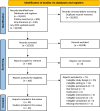Effectiveness of physical rehabilitation for physical functioning and quality of life in long-term care residents with dementia: a systematic review and meta-analysis
- PMID: 38915237
- PMCID: PMC11321609
- DOI: 10.11124/JBIES-23-00431
Effectiveness of physical rehabilitation for physical functioning and quality of life in long-term care residents with dementia: a systematic review and meta-analysis
Abstract
Objective: The objective of this review was to evaluate the effectiveness of physical rehabilitation vs non-rehabilitation comparators for physical functioning and quality of life in long-term care (LTC) residents with dementia.
Introduction: LTC residents living with dementia often have impaired physical functioning and quality of life. Physical rehabilitation can improve physical functioning and quality of life for individuals living with dementia; however, many LTC residents with dementia do not receive physical rehabilitation and providers are unsure what interventions to employ. A synthesis of studies examining physical rehabilitation will help guide practice in the LTC sector where most residents live with dementia. Previous syntheses have focused on all residents in LTC, specific professions, interventions, or people with dementia in the community. Our review focused on LTC residents with dementia and used a broader definition of physical rehabilitation.
Inclusion criteria: This review included studies that evaluated physical rehabilitation in comparison with non-rehabilitation controls among LTC residents with any severity of dementia. We included experimental and quasi-experimental studies that measured the effect on activities of daily living, performance-based physical functioning, and self- or proxy-rated quality of life.
Methods: Searches were conducted in APA PsycINFO (EBSCOhost), CINAHL (EBSCOhost), PubMed (National Library of Medicine), Embase, Scopus, and the Cochrane CENTRAL database with no date or language limitations. Two independent reviewers assessed the studies against the inclusion criteria. Two independent reviewers extracted data and conducted a methodological quality assessment using standardized checklists from JBI. Certainty of evidence was ascertained using the Grading of Recommendations, Assessment, Development and Evaluation (GRADE) approach. Where possible, studies were pooled in meta-analyses; otherwise, a narrative synthesis was presented.
Results: Thirty-three studies were included (n=3072 participants); 27 were randomized controlled trials and (RCTs) the remaining 6 were non-randomized trials. The overall risk of bias of the included studies was low to unclear. Many of the included studies focused on increasing activity or walking, while few were individually tailored or at an intensity appropriate to induce therapeutic effects on physical function. Physical function was measured via several outcome measures, limiting our ability to pool results. There was low-certainty evidence that physical rehabilitation improved activities of daily living assessed with multiple instruments (12 RCTs, 1348 participants, standardized mean difference [SMD] 0.78; 95% CI 0.27 to 1.30) and lower extremity function assessed with the Short Physical Performance Battery Score (3 RCTs, 258 participants, mean difference [MD] 3.01 points; 95% CI 1.37 to 4.66), compared with non-rehabilitation interventions. There was very low- to moderate-certainty evidence that physical rehabilitation demonstrated no change in the 30-Second Sit to Stand Test (2 RCTs, 293 participants, MD 0.79 repetitions; 95% CI -0.45 to 2.03), 6-Minute Walk Test (4 RCTs, 363 participants, MD 17.32 meters; 95% CI -29.41 to 64.05), Timed Walk Test (4 RCTs, 400 participants, MD 0.10 meters/seconds; 95% CI -0.02 to 0.22), Timed Up and Go Test (3 RCTs, 275 participants, MD -2.89 seconds; 95% CI -6.62 to 0.84), or quality of life (4 RCTs, 419 participants, SMD 0.20; 95% CI -0.08 to 0.47).
Conclusions: This review demonstrates that physical rehabilitation may improve activities of daily living for LTC residents living with dementia, although the evidence is of low certainty. The effect of physical rehabilitation on specific functional tasks, such as gait speed and quality of life, are less clear. Future research should examine the effects of individualized, progressive interventions on outcome measures that reflect the capacity and preferences of LTC residents with more advanced dementia.
Review registration: PROSPERO CRD42022308444.
Copyright © 2024 The Author(s). Published by Wolters Kluwer Health, Inc. on Behalf of JBI.
Conflict of interest statement
The authors declare no conflicts of interest.
Figures











Similar articles
-
Folic acid supplementation and malaria susceptibility and severity among people taking antifolate antimalarial drugs in endemic areas.Cochrane Database Syst Rev. 2022 Feb 1;2(2022):CD014217. doi: 10.1002/14651858.CD014217. Cochrane Database Syst Rev. 2022. PMID: 36321557 Free PMC article.
-
Effectiveness of physical rehabilitation in improving physical functioning and quality of life for long-term-care residents with dementia: a systematic review protocol.JBI Evid Synth. 2023 Jan 1;21(1):207-213. doi: 10.11124/JBIES-22-00096. JBI Evid Synth. 2023. PMID: 36036561 Free PMC article.
-
Animal-assisted therapy for dementia.Cochrane Database Syst Rev. 2019 Nov 25;2019(11):CD013243. doi: 10.1002/14651858.CD013243.pub2. Cochrane Database Syst Rev. 2019. PMID: 31763689 Free PMC article.
-
Interventions for preventing delirium in older people in institutional long-term care.Cochrane Database Syst Rev. 2019 Apr 23;4(4):CD009537. doi: 10.1002/14651858.CD009537.pub3. Cochrane Database Syst Rev. 2019. PMID: 31012953 Free PMC article.
-
Exergaming for dementia and mild cognitive impairment.Cochrane Database Syst Rev. 2024 Sep 25;9(9):CD013853. doi: 10.1002/14651858.CD013853.pub2. Cochrane Database Syst Rev. 2024. PMID: 39319863 Free PMC article.
Cited by
-
Dementia Moves: protocol for a feasibility study testing a physical rehabilitation program for long-term care residents with moderate to severe dementia.Pilot Feasibility Stud. 2025 Jul 26;11(1):104. doi: 10.1186/s40814-025-01685-7. Pilot Feasibility Stud. 2025. PMID: 40713920 Free PMC article.
References
-
- Canadian Institute of Health Information . When a nursing home is home: how do Canadian nursing homes measure up on quality? [internet]. Canadian Institute of Health Information; 2013. [cited 2024 Jun 2]. Available from: https://neltoolkit.rnao.ca/sites/default/files/CIHI_When%20a%20Nursing%2....
-
- World Health Organization . Dementia: a public health priority [internet]. WHO; 2012. [cited 2023 Aug 22]. Available from: https://www.who.int/publications/i/item/dementia-a-public-health-priority.
-
- Prince M, Bryce R, Albanese E, Wimo A, Ribeiro W, Ferri CP. The global prevalence of dementia: a systematic review and metaanalysis. Alzheimers Dement J Alzheimers Assoc 2013;9(1):63–75.e2. - PubMed
-
- Ng R, Lane N, Tanuseputro P, Mojaverian N, Talarico R, Wodchis WP, et al. . Increasing complexity of new nursing home residents in Ontario, Canada: a serial cross-sectional study. J Am Geriatr Soc 2020;68(6):1293–1300. - PubMed
Publication types
MeSH terms
LinkOut - more resources
Full Text Sources
Medical

